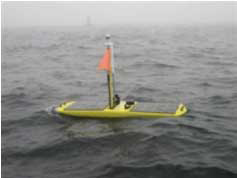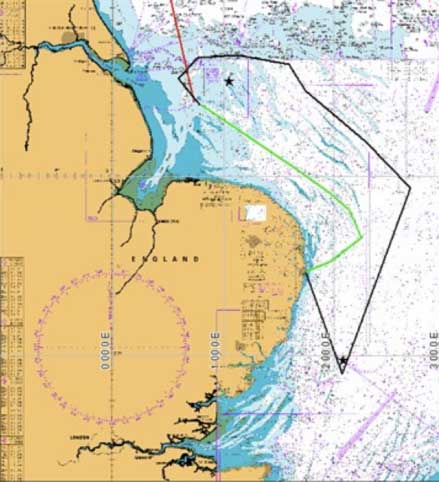by Cefas, UK
Scientists at Cefas are trialling a clever device that looks like a surf board but packs a wide range of sophisticated instruments to record a variety of marine conditions.
The autonomous wave glider, hired from US firm Liquid Robotics, was deployed off Lowestoft on 30 January. This marks the first time such a device has been tested in the southern North Sea, where tides and currents are strong and shipping is busy.
 The 2m-long wave glider is self-propelled by wave action and has the capacity to travel thousands of miles. It is steered remotely from the operations base and has a built-in automatic identification system, which means that it can send alerts with advice to actively avoid shipping.
The 2m-long wave glider is self-propelled by wave action and has the capacity to travel thousands of miles. It is steered remotely from the operations base and has a built-in automatic identification system, which means that it can send alerts with advice to actively avoid shipping.
The suite of systems onboard the device is powered by batteries recharged by solar panels.
Alongside the standard fitments – of weather station, wave height and temperature sensors – the Cefas scientists have added instruments to measure oxygen concentration and saturation, turbidity (water cloudiness), the chlorophyll fluorescence of phytoplankton and salinity. These observations are being recorded by a specially integrated Cefas data logger and data are transmitted to shore via satellite telecommunications in near “real-time”.
During the Cefas trial, which runs to March, the glider will transit north to Cefas’ own Dowsing SmartBuoy site, about 25 miles off the Norfolk and Lincolnshire coasts. There it will make a comparison of the sensors on the wave glider with those on the SmartBuoy. After a few days of monitoring activity, the glider will set off for another SmartBuoy site further south at West Gabbard, 30 miles from the Suffolk and Essex coasts. It will then repeat the same monitoring pattern as at the Dowsing site.
The wave glider travels at around 1.5 knots and will need to cope with strong tides so the 120-mile journey between the two SmartBuoy sites may take several days. Once its work at the Dowsing site is completed, it will turn north and transit back to Lowestoft for recovery (see map).

If the Cefas trial is successful there will be long-term benefits in using wave gliders. Not only will there be validation of a range of environmental characteristics, but there opens up the possibility of more collaborative work with neighbouring European states. Shared marine boundaries with neighbouring states have been areas of contention in the past, so a glider could be programmed to sample transboundary waters across the North Sea for bilateral research studies. This could save money and provide improved scientific understanding of the marine environment.
